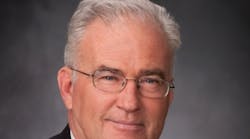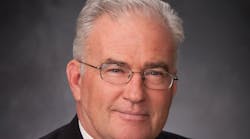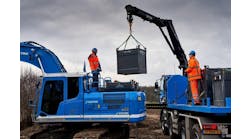Interview with Portland Cement Assn. Economist Ed Sullivan: Uncertainty Slows Growth Prospects
Ed Sullivan, chief economist for the Portland Cement Association, talks about the impact of uncertainty and rising interest rates on the construction market, labor shortages, energy-related construction and more.
RER: The president-elect and his team have talked about an infrastructure stimulus package, but they have not come forward with many details. What do you think?
Sullivan: Let’s backtrack a little bit. Yes it’s hard to predict. You know what that is? That’s a code word for uncertainty. And business does not do well in the context of uncertainty. Any type of infrastructure bill that goes through or potentially goes through isn’t going to have any impact on 2017 because it’s going to take that long just to pass it and then pick the implementation etc. So the key thing that’s going to dominate the economic activity and construction activity is going to be uncertainty. You’ve already seen it occur in certain market actions.
Here’s the first thing. If you have a 4.6 percent unemployment rate as we do now and then talk about a trillion dollar infrastructure bill and you talk about a significant change in terms of tax reform, then you talk about potentially getting rid of illegal laborers, what you’re doing is you’re pushing the unemployment rate below its threshold into the 3’s. What that does now is if I know there are plenty of jobs available for me I demand higher wages, and then wage inflation starts in earnest.
Inflation increases not only from wage increases but overall demand levels are higher. So now you have inflation, and inflation expectations are higher. Now take a step back. What do we see with the bond markets? Bond markets went crazy on the expectation of inflation. And then as a result, interest rates will be higher. We saw it again on the conventional mortgage rates. They went up I believe 50 to 70 basis points. So this uncertainty, not really knowing, and then some of the stuff that was talked about in the campaign, is being digested by the market already. So the way we’re looking at it is interest rates are going to continue to rise. And that’s going to take some steam out of the construction market.
Number 2, you’re going to see that also reflected I think in slower economic growth at least initially. So you have slower non-res and slower residential. The market this year for cement grew by about 2.7 percent, and we’re expecting it to grow at similar levels, 3 percent or so, for next year. But that uncertainty is what is preventing a more robust growth next year.
What impact will the Trump Administration have?
Now anytime there’s a change of administration, and we’re not just talking about the Trump infrastructure plan, there’s typically a bit of a dip in construction activity and economic growth. But then you move on. Now you have to move on to the agenda. And so what we did is, we identified three key initiatives that he would undertake. And not really knowing what the priorities are or when, then we applied a timeline. And then the first thing we do is we say, the things we’re going to look at are the infrastructure bill, tax reform and immigration reform. And we just want to see how that plays out. Now you can go on and talk about imports and all that, and all I think is going to happen and this just adds fuel to the conclusions that we reach. So the first thing that we assume is they attack and get passed an infrastructure bill. And that will occur in 2017.
Now what we did is, yeah, there is talk of a $1 trillion dollar bill, if you see how that surfaced, I believe it was the result of two economists explaining how an infrastructure bank multiplier worked and it could support $1 trillion. I don’t believe that was one of the things Trump said. I’ve heard him say double whatever Clinton is talking about. And so she was putting out $275 billion, so that would boost it up to $550 billion.
So here’s what we did, we took the $1 trillion and we took the $550, we averaged them together and said that’s what he’ll bring before Congress. And then Congress will push it down. And so what we get, what I’ve applied, is a $100 billion program, now it’s a $25 billion program annually in addition to the highway bill. So now you got to stop and say when do we see start seeing those benefits? Well, guess what. If it passed in 2017, and it begins fiscal year 2019, so that means you only start seeing it mid-2018. And then you’ve got to remember, it takes time, whatever this decision process is, we don’t know. So for you to make a decision where it’s going to be spent, and then you got to do the paperwork, and then you’ve got to go select the contractors and review the bids. That all takes time, that can take as little as say seven months to as long as 18 months. But the point is you really won’t see much occurring in 2018.
There’s another issue now to consider. If you’re a state government and I give you x billion dollars more in infrastructure spending, what are you going to do? You’re going to cut back some of your own. You’re still fighting a lot of fiscal initiatives of your own at the state level. So what they call this is sterilization and we’ve assumed 20 percent sterilization. So for every $100 million I give you, it’s really only a net $80 million. So all this works to slow down the impact.
Looking at the highway bill that we do have from the Obama administration, what has that bill done?
It was a five-year bill and it was widely acclaimed. Because what that can do is fund longer-term projects, which for our industry is where we dwell. We dwell on bigger programs, they tend to have a lot of cement usage. But here’s the issue. If you look at that highway bill that was passed, and everyone’s patting themselves on the back, all you did was you basically took the rollover and put an inflation premium on to it. You have a little bit extra for this year, it’s a 5-percent gain, but still if you look at it in terms of real spending, we’re still well below where we were five or six years ago, so in real spending it doesn’t do that much. And the issue is in 25 years you got 50 million more people in the United States, 50 million more drivers, and that’s congestion and that requires a heck of a lot more investment than just basically keeping everything level after inflation is taken out and that’s essentially what the bill does. Now there are obviously some benefits to it but it’s not as wonderful as I’ve heard some make it out to be.
Oil prices seem to be slightly coming back. What do you think about energy spending in general and the effect on the economy?
That really did hit us in 2015 when the oil prices were slow. I think people underestimated the importance and impact of the energy industry as we were recovering. It was adding jobs and it was adding momentum to the economy, and when you kick the rug out under it all that stops. And it’s not just oil or fracking -- it’s the infrastructure that goes with it. You can go to the Dakotas and you can look and say they’re doing great fracking, but someone had to build the homes for these guys, and convenience stores, and bars and restaurants and so on. So there’s the down side. For every ton of cement that we spent on the actual well, three times that much was spent for the supporting industries. So that all disappears and that disrupted us and that did cause a hiccup in overall economic growth.
The Energy Information Agency is expecting prices to rise modestly over the next four or five years. I think by the end of 2020 or so it’s somewhere around $65 a barrel. So it’s a very slow and gradual recovery that they see, and it makes sense. As the oil prices start to climb, even in the context of OPEC, what you’re also going to do is encourage some of those guys that were shut down to re-open and that puts a lid in terms of how high and quickly prices start to head back up again.
What you expect coming up in residential construction?
We expect residential to be more flat because we’ve seen the uncertainty plus the higher mortgage rates. And that’s occurring at a time when home prices are still rising. And so they’ll be a lag effect to all that but we think that there’s a lot of dynamics there that impeded the growth on sales activity on the residential side and those will remain in place and be impeded further by the run-up in mortgage rates. And so we’re looking for that to be flat. So there’s very little growth coming there. So if you stop and think about most construction forecasts, that used to be the powerhouse for growth because stock activity is still extremely low from a historical standpoint, so therefore even a 10-percent gain could be done year after year after year and still be at reasonable historical levels.
How about non-residential?
In non-res again there are certain key areas that I think you can say are going to be hit a little bit harder by this uncertainty. All sectors are going to get hit by uncertainty. Those are investments. If I don’t know how to make a return on this, I’m not going to go through with it. So that will slow down the growth. It won’t make it go to zero but I think it’s going to slow it down. I think we’re looking at a 2- to 3-percent gain in nonresidential spending. You can look at certain areas like hospitals and medical. That’s in absolute decline because of the uncertainty surrounding Obamacare. We don’t know all it means yet but if it does mean fewer people are covered, that means you don’t get as many outpatient calls, etc. and that slows down the whole medical construction arena.
We’ve heard a lot of concern about a lack of skilled labor in the construction workforce. How do you see this playing out?
We’ve done some analysis on this and if you look at the ratio between employment and construction activity it had tremendous movement down during the recession, and now it’s coming back up but it’s never hit its pre-recession ratios. In some areas, that skill shortage is not getting better it’s worsening, and that means its drawdown on construction activity is greater. We’ve identified that we think that takes between 100,000 and 150,000 starts out of residential a year. That’s a lot, that’s huge. Our understanding of the issue is that’s really where you see the biggest problem, on the residential side. So that will be a factor and here’s the thing – the flow, the pipeline of new skilled workers coming in, it’s just not there and that suggests that this thing is going to remain in play as a depressant on overall construction activity for the next five years. And it’s not just construction workers. I know businesses in the cement industry they are not buying new ready-mix trucks, they can’t find drivers.
So it goes well beyond our traditional definition of construction, it’s everything. It’s more the blue-collar skills that are lacking and that will have an impact on overall growth.
Undocumented workers certainly are a part of the construction workforce as well.
Absolutely, and here’s what we say on this one. We may be way off with our assumptions on this one but you have to make assumptions on a lack of knowing. We basically think the way [The Trump Administration] will work this is through executive order. It will meet a lot of resistance if they try to do something legislatively. But they have the power to hire more agents and that’s what [Trump] has suggested. So he said some 5,000 border customs agents, he’s going to increase to 15,000. Well, again, what you’re doing is you’re taking 5 percent of the workforce out and you’re also talking about construction where that percentage is much higher. So now you’re causing real significant issues. That will limit construction activity, no question about it.
So we’ve assumed that the Trump administration understands all this stuff and he’s not going to push it that hard. Because that will reduce economic growth or our ability to produce economic growth. So he will clamp down because he made those promises, but he’s not going to triple the [Border Patrol] workforce, it’s a much slower increase. And so that means a much slower amount of illegal workers that are being pushed out.
The University of Minnesota did a study and it estimated that 550,000 Mexican construction workers left during the recession. Not forced out, they just left. So it is a problem.







